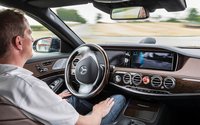 Advertising in cars may
not be just around the corner.
Advertising in cars may
not be just around the corner.
One of the promises of self-driving cars is that advertising or some form of interactions with the would-be drivers and passengers would be appropriate to occupy
the time if not the attention of those in the car.
Various entities, including the auto industry and tech companies like Google, are going full speed ahead to create cars that drive
themselves.
Meanwhile, consumers are hardly lining up to get one.
A new study by the University of Michigan taking a look at consumer attitudes about such cars found that most people
– by a lot – don’t want a car that drives itself.
The study comprised a survey of 618 licensed drivers with demographics matched to the U.S. Census population.
The
university conducted the same study a year ago and found that the market has not really changed much over the year.
advertisement
advertisement
While most (84%) consumers don’t want a self-driving car, some (39%)
would be OK with a partially self-driving car.
And this is pretty much across the board, since there’s little difference in view by age group.
It’s not only desiring a
self-driving car that troubles consumers, most (67%) would be very or moderately concerned about even riding one even if it was the only vehicle available.
On the other side, car makers are
moving full speed ahead on embedding more technology inside cars.
For example, Audi is promoting its virtual cockpit, comprising a large LCD screen with an animated instrument cluster.
And BMW is looking at a future where a car parks itself, pulls out of its spot and re-parks in the garage back at home.
And Google continues to add miles to its fleet of autonomous
vehicles.
If self-driving cars ever are accepted into the market, the resulting issue will be what a person in the car does while it is being driven by itself.
They could read a book,
watch a movie or enjoy the scenery.
Marketers may come up with some other ideas.